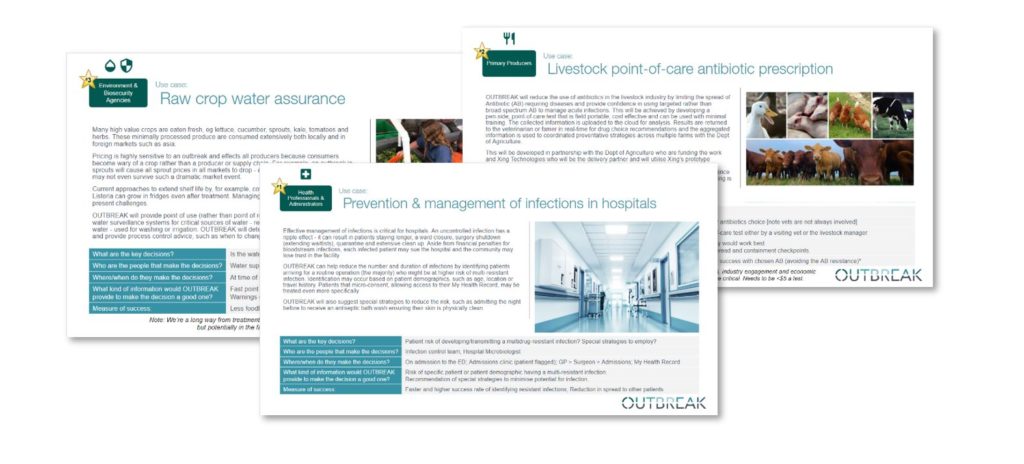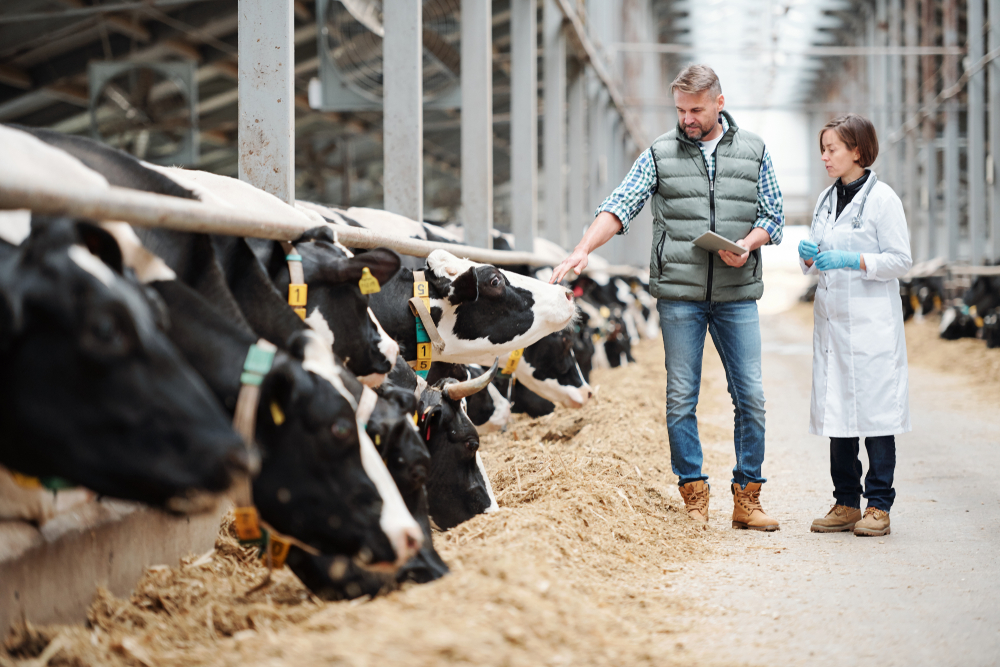 OUTBREAK’s Chief Technology Officer, Ian Pridham, explains the process of developing a world-first AI system with many complexities and potential users…
OUTBREAK’s Chief Technology Officer, Ian Pridham, explains the process of developing a world-first AI system with many complexities and potential users…
Q: What is your role in the OUTBREAK project?
My role is to make sure that we build technology and products that work. That’s it. The right products matching our end users’ needs, with all the complex technology underneath coming together in the right ways to accurately and reliably deliver value to our users.
Q: OUTBREAK is a huge project, where did you start?
All our truly wonderful scientists look at things from the bottom up, from the science. So, my first questions were top down: ‘Who’s going to use this? And how will it fit into their individual day-to-day workflow?’ Branwen, our CEO, endorsed this approach immediately.
I broke it down across six different kinds of user and that is a really broad set of people, which is part of the reason it is difficult to understand OUTBREAK when you first look at it. Then we consider different “use cases” – they’re examples of how different people might use the system.


Q: Is that a normal project approach?
It isn’t necessarily normal but it is best practice. Whenever you’re developing new products and services, the technology must serve a purpose. In simple terms, the purpose is whatever its final users need it to do.
Q: There are a lot of organisations involved in OUTBREAK, so how do you keep them focused on the end users?
That’s why I initiated the use cases, they show the key difference OUTBREAK is going to make to people in their diverse real-world scenarios. This creates a picture in a structured way so that everyone really starts thinking with the end users in mind. I also made it clear that the journey for a person doesn’t necessarily begin when they start using your product – it may start well before and it may finish well after – so, what is the whole journey?

Q: So, once you had the architecture and the use cases selected, where to?
There are a lot of moving parts, so we’re working on key components simultaneously. We’ve collected a list of over 300 data sets from various areas that cover very different kinds of information – for example: demographics, drug prescriptions, weather patterns – I call that the data landscape.
Q: How complicated is that data?
It’s complicated in many ways. No one collects this data and matches it, so that’s one challenge. There are no real standards, especially when you attempt to link data for humans, animals and the environment.
The other challenge is the way that the data is formatted. A lot of the data we want is unstructured and that makes things a lot harder. For example, a pharmacy prescription might be a doctor’s free form notes. How are you going to process that and pull out the important information? You’ve got to use modern, clever approaches like natural language processing to figure out what’s in that text.
The third major challenge is the data being very sparse – we don’t have data about certain points or at certain times. It’s like looking at a foreign movie with two-thirds of the subtitles missing and then trying to map that onto someone’s photo library. They’re very different, difficult to comprehend, and key information is absent.
Q: So, what’s the solution?
A lot of modern techniques based on artificial intelligence can figure out what’s in that text. Machine learning, for example, can deal with matching diverse formats and diverse data sets.
Q: What about data security?
Security and privacy are absolutely essential for us. We don’t want to inadvertently identify an individual. The data must be anonymised at the source but how do we map anonymised data to other anonymised data? Again, it’s all about best practice – using the latest and very best architecture and solutions.
Q: Have you had any issues accessing the data you need for the use cases?
Absolutely. Ethics approvals that were submitted last year may not be approved until next year. There’s a long lead time to certain kinds of information because it’s very sensitive.
Q: Are people coming to accept that they are going to have to surrender a level of privacy to use data to do good?
There are ways that privacy can be maintained even while giving access to your data. Often people think it’s an “either-or” and it doesn’t have to be. One of the things we really want to work on is a concept called micro-consenting. The idea is that you can consent to your data being used only by the people you want it to be used by, for only the specific purpose that you want it used, and only for a specific amount of time. That allows you to protect your privacy in the future and get the benefit of sharing.
Q: Like a limited copyright?
Yes, mechanisms can be put in place to ensure no one else can get hold of your data for any other purpose, or any other period of time, than what you explicitly permit. You control your data.
Q: Are there any other challenges for OUTBREAK?
The next big challenge for OUTBREAK is building the inference engine (an artificial intelligence program that is used to make logical deductions, like weather forecasting). Our engine will use the data we gather to predict the risk of antimicrobial resistance for an individual person at a specific location.
For example, we can ask the inference engine “I’m in hospital, here are some personal details and my postcode” and it will detail the kind of antimicrobial resistance risk you have. You may have an 80% chance of being resistant to one type of antibiotic but 10% chance with another one, so you opt for the lower risk drug.
The more information you decide to provide the inference engine, the more personalised it is. For example, have you visited a specific country or some hotspot that we know about?
 Q: How will that inference engine help farmers reduce antibiotic use and antimicrobial resistance?
Q: How will that inference engine help farmers reduce antibiotic use and antimicrobial resistance?
We created use cases that show how OUTBREAK will support dairy farmers and raw vegetable crop farmers. For example, OUTBREAK would recommend to farmers which antibiotic to use to treat their herd animals with mastitis, allowing the cows to recover and return to milk production quickly.
There’s a big market for organic produce so it’s possible that consumers are going to want low-antibiotic produce.
On an international level, there are trade agreements being drawn up that regulate antibiotic and antimicrobial resistance levels. Australia has a reputation for very high quality produce, so keeping that reputation will be important for trade.
Q: Is there anything unique in terms of the technology being used?
The inference engine itself, that will be brand new and purpose-built from the ground up. There simply isn’t anything out there that does what we need.
Q: Will it have an interface that would be recognisable to the public?
There will be interfaces that are recognisable to each user. For example, General Practitioners are accustomed to receiving information on a pathology report, so that report could be adapted to include a section on a patient’s risk of antibiotic resistance.
While OUTBREAK’s database will be “one”, the useable products will be “many”. The products will present the data in the most valuable, usable way possible. You can imagine a phone app that tells you if it’s safe to go surfing or what kind of foods are going to be good for you, to help you understand your options.
Q: How do you ensure that the data used by OUTBREAK is the latest or is being updated?
The data will come through with timestamps. If some of the data comes in late, we’ll make our best assessment of the risk with the best data available, and, as more data arrives, we will update and revise it.
For example, when you are given a prescription, it’s based on your doctor’s best assessment at that point in time. But more information comes in later on, say from a blood test. OUTBREAK will flag that you currently have a prescription and notify the General Practitioner, even months later, that you are using one antibiotic but might be better off on a different one.
Technology can deal with a lack of data but, as the data gets better, it can also reassess the situation which is very difficult for humans to do.
Q: That sounds like real-time medicine, it’s incredible.
Real-time and personalised.
 Q: You said OUTBREAK has to be built from the ground up, there’s nothing like it. How do you do that?
Q: You said OUTBREAK has to be built from the ground up, there’s nothing like it. How do you do that?
We’re using the cloud as much as possible. Some of the data will be in different clouds, so we need a multi-cloud architecture that bridges and integrates those diverse platforms.
Some of this data is actually very big – the gene data is the biggest – so it isn’t feasible to move it around.
Q: How long do you imagine it will take to build the OUTBREAK system?
That is part of my work over the coming months. What I do know is, we’ll do it incrementally. We’ll do what we can, as soon as we can.
We’ve started with urinary tract infections because they affect millions of Australians every year. This is a really big problem but it’s only one problem we can tackle. We solve one problem for one user, then move on and keep expanding. OUTBREAK will continue to evolve for years to come.
Q: OUTBREAK has international application; do you think there’s an appetite overseas?
Definitely, antimicrobial resistance is a global problem and no one, as best as we can tell, is looking to solve this as comprehensively as we are. Australia is positioned to be the global leader. You can immediately see how Australia could duplicate and adapt OUTBREAK to help other countries to save lives.
Ian Pridham is an experienced digital transformation strategist and company founder.

